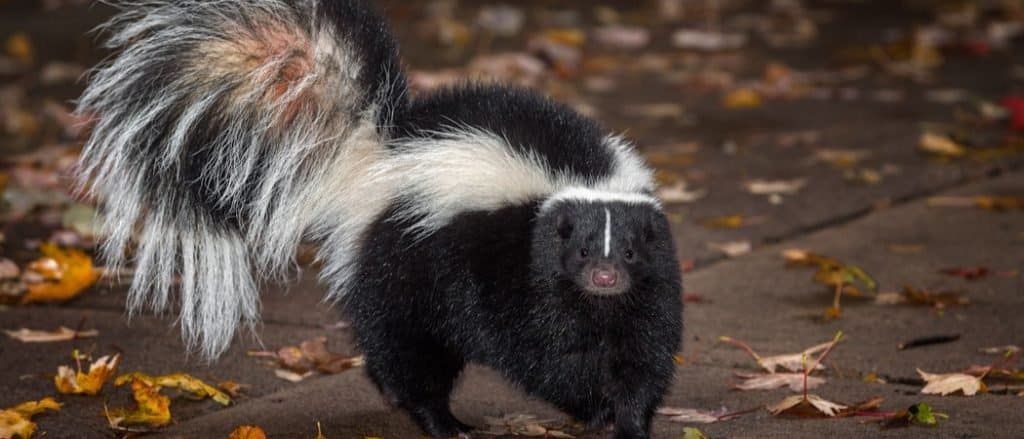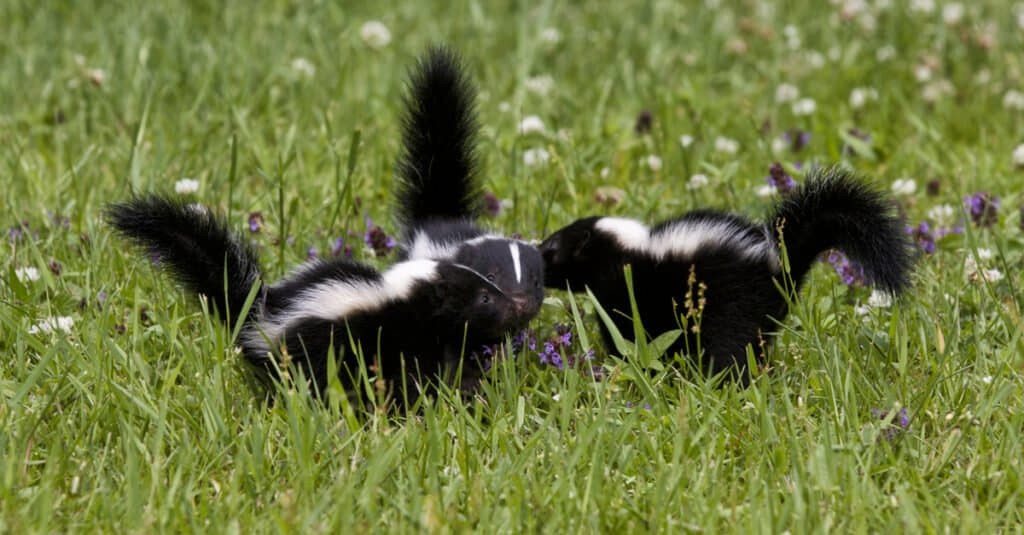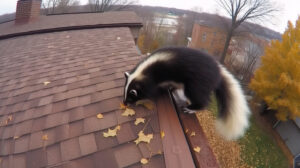Skunks are small mammals that are characterized by their ability to spray unpleasant smelling liquid from their anal glands which they use as a defense mechanism with great success. They are native to the US, Canada, and South America where they live in forest edges, woodlands, grasslands, and deserts. Skunks are omnivores and are known for being opportunistic eaters. But what of their teeth? Join us as we discover everything you need to know about skunk teeth!
Skunk Teeth
There are twelve species of skunks and although they are related to polecats and weasels, their closest relatives are Old World stink badgers. Both Old World stink badgers and skunks are members of the Mephitidae family and are best known for the strong smelling liquid that they produce.
Skunks are usually black and white, although colors can vary. They have short, muscular legs and an elongated body. Skunks have five toes on each foot and long front claws which they use for digging. They have an excellent sense of smell and acute hearing, but poor vision.
Skunks have 34 adult teeth in total, but prior to that they have a set of deciduous (milk) teeth. Before the adult teeth erupt, each permanent tooth has a small, functionless deciduous tooth in it’s place. These small deciduous teeth are always either shed or resorbed by the 40th day after birth. As their deciduous teeth don’t actually have a function, baby skunks rely solely on their mother’s milk for survival for the first six weeks of their lives.
Adult Teeth

Skunks have 34 adult teeth which erupt 40 to 52 days after birth
©Geoffrey Kuchera/Shutterstock.com
Skunks have twelve incisors, four canines, twelve premolars, and six molars (two upper and four lower). All of the permanent adult teeth erupt between 40 and 52 days after birth. The incisors erupt first, then the premolars, canines, and lastly the molars. The first two upper premolars and all three lower premolars erupt at virtually the same time. However, the upper molar erupts before the lower molars do.
The main feature of skunks teeth is the large and prominent canine teeth which are sharp and slightly curved. These teeth are used for piercing and killing prey. The incisors at the front of the mouth are also incredibly sharp and are used for grabbing and slicing their food.
Skunks, like many other meat-eaters, have a set of carnassial teeth. Carnassial teeth in skunks are the last upper molar and the first lower molar. These teeth are often described as being “blade-like”. Carnassial teeth are extremely well developed in skunks and work with a shearing or scissor-like action. They are used for slicing the meat of their prey and cutting through tough areas. Additionally, the first upper molar is particularly broad and is used as a crushing tooth.
What do Skunks use their Teeth for?

Skunks fight over den space
©Debbie Steinhausser/Shutterstock.com
Obviously, the main purpose that skunks use their teeth for is eating, and they certainly use them to great effect. Skunks are omnivores – so they eat both plants and animals – but they are opportunistic predators. This means that they eat what they think they can safely overcome. Their diet varies and, along with plants, they eat insects, worms, rodents, lizards, salamanders, frogs, snails, birds, and moles. However, they also act as scavengers and eat bird and rodent carcasses that have been left by cats and other animals.
Skunks are also known for their ability for breaking into chicken sheds and attacking chickens. Skunks are excellent predators and attack the head and neck of the chicken and then tear out the throat using their super-sharp teeth. They are extremely bold don’t readily run away if disturbed. They tend to sit and eat what they want, not leaving until they have eaten their fill unless they are forced to.
Skunks are the main predator of honeybees and are uniquely adapted to catching their chosen meal as their thick fur protects them from stings. The only regular predator of skunks is the great horned owl. Animals such as wolves, foxes, and badgers rarely attack them for fear of being sprayed.
However, eating isn’t the only thing that skunks use their teeth for – they use them for fighting too! Although skunks are usually solitary animals, they do sometimes come into contact with other skunks. Skunks are crepuscular which means they are most active during the twilight hours. During the day they often shelter in burrows. Sometimes they try to share the same den, especially during winter, and when they do fights often break out. Fights between skunks usually involve both teeth and claws and can be vicious and bloody.
The Beast of Five Teeth

Prehistoric skunks were much larger and thr earliest ones ate only plants
©Jeremy Richards/Shutterstock.com
Skunks have been around in their current form for several million years, with fossil records dating back to the early Pleistocene. However, skunks have actually been around in some form for even longer. One of the earliest skunks to have existed was Orretherium tzen. The name is derived from a mixture of Greek and a local indigenous language and means “beast of five teeth”. The beast of five teeth earned it’s name because part of a fossilized jawbone was found in Chile with five teeth still attached.
This early skunk dates back to the Cretaceous period between 72 and 74 million years ago and was much larger than the skunks we know today. The fossilized teeth found were cheek teeth – lower premolars and molars and one upper premolar. Based on the teeth and using knowledge of the flora and fauna during that period, scientists were able to determine what it ate. Despite it’s name coining it a “beast”, this prehistoric skunk was actually a herbivore.
The photo featured at the top of this post is © Jeremy Richards/Shutterstock.com
Thank you for reading! Have some feedback for us? Contact the AZ Animals editorial team.





